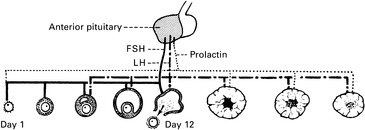OVULATION
Development of the ovarian follicle occurs in response to stimulation from the pituitary gland.
The hypothalamus and pituitary are intimately associated. Together they regulate ovarian structure and function throughout the menstrual cycle.
The hypothalamus produces gonadotrophin releasing hormone (GnRH) in a pulsatile fashion and this in turn stimulates production of the gonadotrophins follicle stimulating hormone (FSH) and luteinising hormone (LH).
PITUITARY CONTROL OF OVARY
The ovarian changes are controlled mainly by the anterior pituitary which produces three principal hormones: follicle stimulating hormone (FSH) stimulates follicular growth. Luteinising hormone (LH) stimulates ovulation and causes luteinisation of granulosa cells after escape of the ovum. Prolactin is also produced by the anterior pituitary.
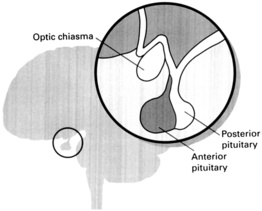 |
OVULATION AND MENSTRUATION
At the end of the menstrual cycle oestrogen levels are low. Low oestrogen levels stimulate production of FSH by the pituitary. FSH in turn acts upon the ovary to stimulate growth of ovarian follicles. The increasing levels of oestrogen produced by the developing follicles act on the pituitary to reduce FSH levels by the process of negative feedback. In the majority of cycles only one follicle, the so-called dominant follicle, is sufficiently large and has a greater density of FSH receptors to respond to the lower FSH levels and develops to the stage of ovulation. Non-identical twinning results when more than one follicle proceeds to ovulation. Oestrogen levels continue to rise. In the mid-cycle the nature of the ovarian control of pituitary function changes. Increasing oestrogen levels are required to produce a positive feedback mechanism which causes a surge in FSH and LH levels. This surge evokes ovulation. LH acts to increase local production of prostaglandins and proteolytic enzymes to allow oocyte extrusion. LH is responsible for the development of the corpus luteum which produces progesterone.
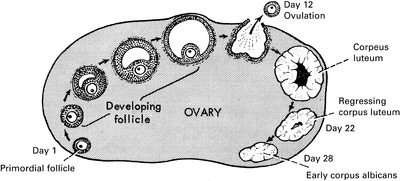 |
MENSTRUATION
These alterations in oestrogen and progesterone levels are responsible for the dramatic changes in the endometrium throughout the ovarian cycle. At the completion of the menstrual period the endometrium is only one to two millimetres thick. Under the influence of increasing levels of oestrogen this increases until by day 12 of the cycle the endometrium is 10 to 12mm thick. This growth results from an increase in epithelial and stromal cells of the superficial layer of endometrium. This Proliferative Phase is characterised by an increase in oestrogen receptor content and increase in size of the endometrial glands.
As ovulation approaches, the progesterone receptor content increases. Within two days of ovulation the effect of ovarian production of progesterone becomes apparent as the endometrium enters the Secretory Phase of the cycle. During this phase the mitotic activity in the epithelium ceases and the glands become dilated and tortuous. The blood vessels become more coiled. Glycogen accumulation in the endometrium reaches a peak under the combined influence of oestrogen and progesterone. These processes prepare the endometrium for embedding of the embryo. If fertilisation does not occur then progesterone and oestrogen levels decline and menstruation occurs.
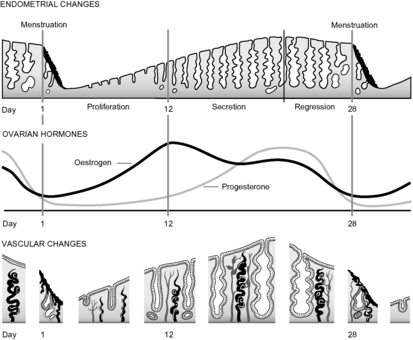 |
FERTILISATION
Fertilisation, if it occurs, takes place in the fallopian tube. The zygote divides repeatedly to form a solid sphere of cells as it passes down the fallopian tube and into the uterine cavity. The developing embryo begins to differentiate into the tissue which will become the fetus and that which will form the placenta and fetal membranes. The primitive precursor of the chorionic membrane produces human chorionic gonadotrophin (HCG). HCG has a biological action very similar to LH and takes over its luteinising function.
For the first fourteen days after fertilisation uterine growth and the development of the decidua (the endometrium of pregnancy) are dictated by the corpus luteum under the influence of the pituitary. Thereafter the pituitary LH levels are reduced in response to the increasing levels of HCG.
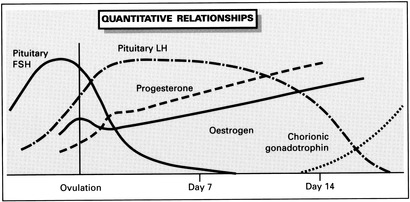 |
Under the influence of chorionic gonadotrophin the corpus luteum continues to grow and to secrete ovarian steroids for the maintenance of uterine growth. HCG levels reach a peak around 10 to 12 weeks and thereafter decline to a lower constant level throughout pregnancy. The response to this reduction is a decrease in ovarian oestrogen and progestogen output. As the ovarian contribution to maintaining the pregnancy declines, the placenta increases steroid production. Placental steroid production is impressive and analogues of both hypothalamic and pituitary hormones are produced. The capacity to produce these hormones increases as the early placenta develops.

Full access? Get Clinical Tree


